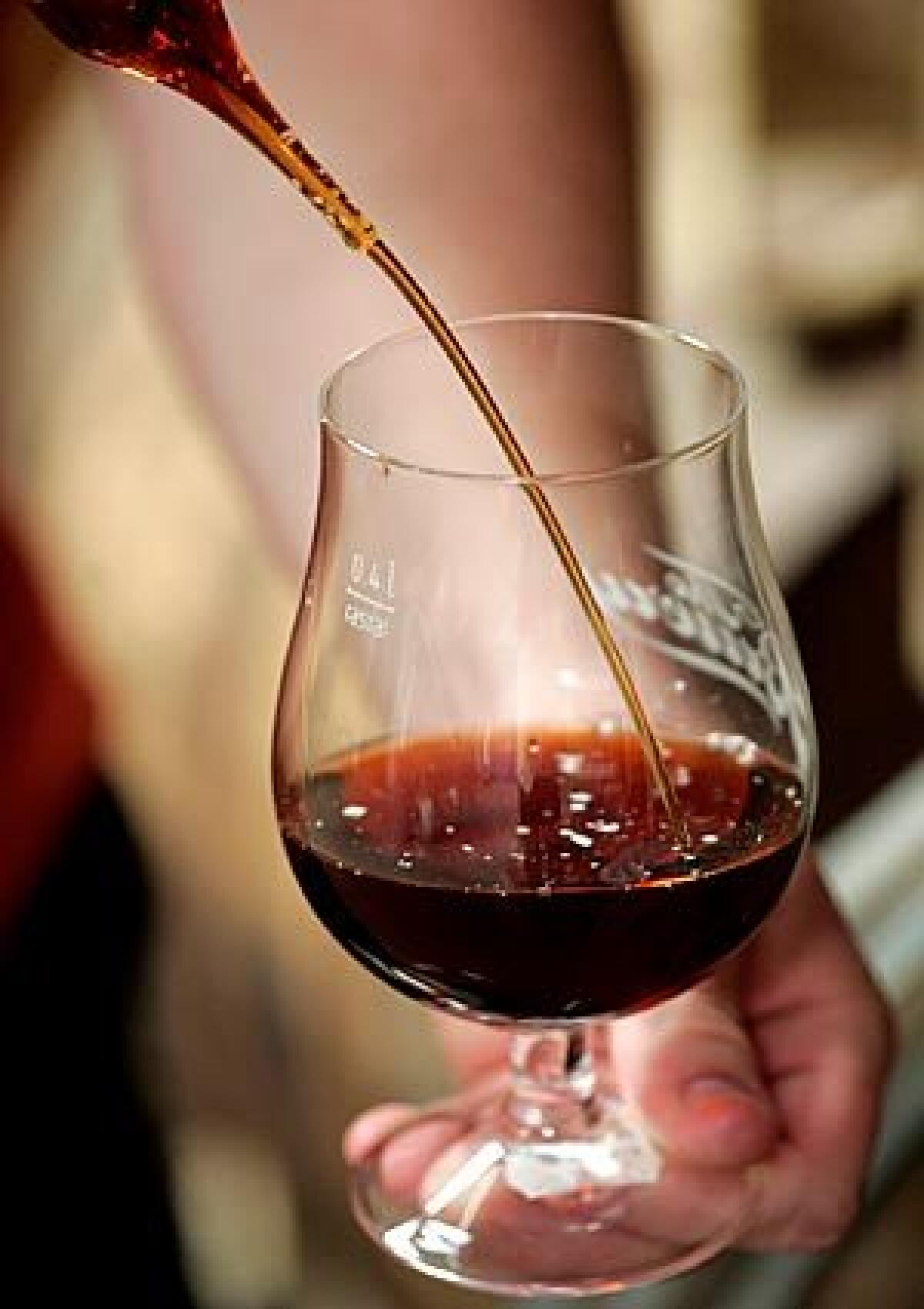Sour beer? Pucker up

- Share via
A bartender pulls on the beer tap handle, and a rosy liquid streams into a waiting glass. Take a sniff and it smells like a barnyard. The bartender assures you that it tastes a lot better than it smells. So you take a sip. It’s tart enough to make your lips pucker, but you can’t wait to take another sip. This is Chez Monmee, a tart cherry ale from Alpine Beer Co. that’s part of a new wave of refreshing American sour beers.
Ten years ago, domestic sours were nearly nonexistent. Now a band of American brewers, including several in Southern California, is drawing on Belgian traditions to produce distinctly sour lambics, gueuzes, krieks and Flanders-style red ales. Though still relatively rare, they’re showing up at some of L.A.’s better beer bars. Proprietors such as Verdugo Bar’s Ryan Sweeney, the Golden State’s Jason Bernstein and Blue Palms Brewhouse’s Brian Lenzo are regularly stocking stateside sours.
Restaurant owner Bernstein appreciates how sour beer “allows new flavors to emerge in food that wouldn’t normally be enhanced by hops. The other charming thing is that sours tend to be relatively low in alcohol” and thus sip smooth for the summer.
Patrick Rue launched the Bruery, his Belgian-style brewery in Placentia, last year, and sours have been a focus from the start. At its first-anniversary party in May, it had a four-tap sour bar, including Cuvée Jeune, a young lambic aged in Chardonnay barrels for 10 months. White Zin is a sweeter variation on Cuvée Jeune, blended with a brew made with Zinfandel grapes. Gypsy Tart was Rue’s limited-edition Flanders red that was untouched by wood, and plenty sour.
“The classic beer palate is malty, sweet and bitter,” says Craftsman Brewing Co.’s Mark Jilg, who began brewing sours six years ago in Pasadena. He considers sours “the final frontier of palate experience.”
Jilg regularly brews a tart cherry beer called Honestly Ale, released a black sour called El Prieto in November and has several more varieties in the works.
Sour beers are only now gaining acceptance stateside, but they’re hardly new. “Sour beers are our connection to the ancient history of beer,” says Colby Chandler, president of the San Diego Brewers Guild. “Someone was drinking a similar beverage dating back to the 6th millennium BC.”
A certain mystique
Traditional sour styles include unblended lambics that ferment in oak barrels in Belgium’s Senne Valley. Brewers add fruit to develop tart framboise (raspberry) and krieks (cherry), to name just two tangy options. Gueuzes blend three consecutive lambic vintages to balance flavors, minimize astringency and create carbonation. Flanders red ales can be intensely tart.
Alex Macy, who heads the beer program at downtown’s BottleRock, appreciates “the acidity, the aftertaste, and the mystique in the way it’s produced. It’s the romanticism of beer being brewed in an open barn with crazy wild yeast.”
Macy is alluding to traditional Belgian fermentation methods. Very few American brewers take the time (and risk) to let natural bacteria take its course, but that’s what brew master Ron Jeffries is doing at Jolly Pumpkin Artisan Ales in Dexter, Mich. America’s only 100% oak-aged sour brewery uses wild yeasts that appeared in the brewery naturally and spread from barrel to barrel during transfers.
Allagash Brewing Co. has raised the stakes by installing America’s only Belgian-style cool ship in its Portland, Maine, brewery. “Granted, it made no financial sense,” says brew master Jason Perkins, “but we figured why not?” An unfermented grain-enriched liquid called wort is pumped into a 12-by-8-by-1-foot tray (the cool ship). Open windows cool the brew to 60 degrees and invite naturally occurring bacteria and yeasts, which spontaneously ferment the beer. The wort then enters French oak barrels, where the beer ferments for more than a year.
Sour beers provide brewers with unique challenges. “A common misconception among brewers is that all it takes is an oak barrel and a vial of bugs and you get a sour beer,” says Perkins. “In reality, it takes a lot more than that.” Breweries must be willing to commit the space and expense and patiently endure an unpredictable aging process.
Another major challenge is controlling the aggressive microbes. Brewers must isolate the barrels so that the bacteria don’t cross-contaminate other batches. At Alpine Beer Co., a brewery east of San Diego, brew master Pat McIlhenney uses separate hoses, separate fermenter gaskets and unique bottling machines. Exposed tanks and barrels are nearly impossible to de-sour.
Microbial unpredictability is another variable. “It can be difficult to measure how well they are turning out because there is often excessive sulfur, sometimes they aren’t very sour, or sometimes they become sour very quickly,” says the Bruery’s Rue.
“When we get it right, though, it is all worthwhile,” adds Russian River brew master Vinnie Cilurzo.
Microbiology
Standard bacteria (lactobacillus, pediococcus) and wild yeasts (brettanomyces) are widely available from labs and commercial suppliers, and many brewers have developed custom microbe blends. “The art for the brewer is picking the right strains, growing them up effectively and choosing the right venue for them to be used,” says Perkins.
American brewers are mindful of sour Belgian heritage but are straying from traditional oak-barrel fermentation to produce unique flavors. Cilurzo is currently aging a brown sour cherry ale called Supplication in Pinot Noir barrels and black currant-tinged Consecration in Cabernet Sauvignon barrels. Alpine’s Halloween release -- Ichabod -- will be tart and lightly flavored with pumpkin, cinnamon and nutmeg.
Bourbon barrels have become increasingly popular. To be considered “straight bourbon,” Kentucky distilleries can use their barrels only once. Kentucky’s loss is Ballast Point’s gain. For the sour version of the San Diego brewery’s Black Marlin Porter, brew master Colby Chandler blends beers fermented in three different bourbon barrels to develop “layers of flavor” -- Jim Beam for vanilla, Heaven Hill for cherry and Old Fitzgerald for smokiness.
For Sour Wench, Chandler avoids barrel aging altogether but still sours the mash with a pound of tart Oregon blackberries per gallon.
Southern Californians have two upcoming opportunities to immerse themselves in sour beer culture. On July 19, Stone Brewing is hosting its third annual Sour Fest in Escondido. Newly installed beverage coordinator Bill Sysak has visited Belgium 30 times and promises the selection will be “decadent, more extreme” than previous years, with close to 50 kegs, plus plenty of bottled lambics.
Beachwood BBQ proprietor Gabriel Gordon has been hoarding kegs for more than two years for Sour Fest at his restaurant in Seal Beach. The Aug. 25-31 festival will feature 18 sours on tap at any given time, including Russian River Consecration and the Bruery’s sours, plus nightly brewery events.
“I’ve seen the evolution of beer drinkers in general,” says Alpine’s McIlhenney, “how Sierra Nevada pale ale used to be, ‘Whoa, oh, my God, too strong flavored.’ Eventually it became a fairly accepted beer. . . . Sour beers are the next step.”
More to Read
Eat your way across L.A.
Get our weekly Tasting Notes newsletter for reviews, news and more.
You may occasionally receive promotional content from the Los Angeles Times.









